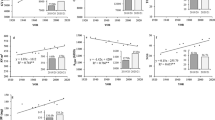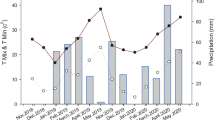Abstract
Spike fertility index (SF) has been proposed as a promising trait to be used as a selection criterion in wheat breeding programs aimed at increasing grain yield, but no actual evidence of its successful application has been reported. In this study, 146 recombinant inbred lines derived from a cross between ‘Baguette 10’ and ‘Klein Chajá’, Argentinean spring bread wheat cultivars with contrasting SF, were evaluated during three crop seasons (2013, 2014 and 2015) at Balcarce, Argentina. Grain yield, grain number/m2, grain weight, and SF were measured at maturity. Changes in grain yield (i.e., responses to selection) after application of different selection strategies, including different selection criteria and selection intensities, were determined. Significant correlations were observed between grain number and grain yield, SF and grain yield, and SF and grain weight. Analysis of SF variance components showed a significant genotype × environment interaction, but it represented only 9% of the total variation, whereas 51% of the variation was genetic, resulting in a high narrow-sense heritability (0.84). The use of SF as a selection criterion, either solely or in combination with selection for high yield, increased yield, resulting in higher and more stable yields than if selecting for high yield alone. Our findings support the use of spike fertility index as a selection criterion for increasing genetic progress and stability of yield in bread wheat breeding programs.



Similar content being viewed by others
References
Abbate PE, Andrade FH, Lázaro L, Bariffi JH, Berardocco HG, Inza VH, Marturano F (1998) Grain yield increase in recent Argentine wheat cultivars. Crop Sci 38:1203–1209. https://doi.org/10.2135/cropsci1998.0011183X003800050015x
Abbate PE, López JR, Brach AM, Gutheim F, González F (2007) Estabilidad de la fertilidad de las espigas de trigo en ambientes sub-potenciales. In: Workshop Internacional: Ecofisiología vegetal aplicada al estudio de la determinación del rendimiento y la calidad de los cultivos de granos. Mar del Plata, Buenos Aires, Argentina, September 6–7, pp 2–3
Abbate PE, Pontaroli AC, Lazaro L, Gutheim F (2013) A method of screening for spike fertility in wheat. J Agric Sci 151:322–330. https://doi.org/10.1017/s0021859612000068
Acreche MM, Briceño-Félix G, Sánchez JAM, Slafer GA (2008) Physiological bases of genetic gains in Mediterranean bread wheat yield in Spain. Eur J Agron 28:162–170. https://doi.org/10.1016/j.eja.2007.07.001
Alonso MP, Abbate PE, Mirabella NE, Aramburu Merlos F, Panelo JS, Pontaroli AC (2018) Analysis of sink/source relations in bread wheat recombinant inbred lines and commercial cultivars under a high yield potential environment. Eur J Agron 93:8–87. https://doi.org/10.1016/j.eja.2017.11.007
Arguello MN, Mason RE, Roberts TL, Subramanian N, Acuña A, Addison CK, Lozada DN, Miller RG, Gbur E (2016) Performance of soft red winter wheat subjected to field soil waterlogging: grain yield and yield components. Field Crop Res 194:57–64. https://doi.org/10.1016/j.fcr.2016.04.040
Austin RB (1982) Crop characteristics and the potential yield of wheat. J Agric Sci 98:447–453. https://doi.org/10.1017/S002185960004199X
Borrás L, Slafer GA, Otegui ME (2004) Seed dry weight response to source–sink manipulations in wheat, maize and soybean: a quantitative reappraisal. Field Crop Res 86:131–146. https://doi.org/10.1016/j.fcr.2003.08.002
Bustos DV, Hasan A, Reynolds MP, Calderini DF (2013) Combining high grain number and weight through a DH-population to improve grain yield potential of wheat in high-yielding environments. Field Crop Res 145:106–115. https://doi.org/10.1016/j.fcr.2013.01.015
CIMMYT (2017) Wheat Research. <http://www.cimmyt.org/global-wheat-research>. Accessed: Sept 16 2017
Cooper M, Stucker RE, DeLacy IH, Harch BD (1997) Wheat breeding nurseries, target environments, and indirect selection for grain yield. Crop Sci 37:1168–1176. https://doi.org/10.2135/cropsci1997.0011183X003700040024x
Elía M, Savin R, Slafer GA (2016) Fruiting efficiency in wheat: physiological aspects and genetic variation among modern cultivars. Field Crop Res 191:83–90. https://doi.org/10.1016/j.fcr.2016.02.019
Ferrante A, Savin R, Slafer GA (2012) Differences in yield physiology between modern, well adapted durum wheat cultivars grown under contrasting conditions. Field Crop Res 136:52–64. https://doi.org/10.1016/j.fcr.2012.07.015
Ferrante A, Savin R, Slafer GA (2015) Relationship between fruiting efficiency and grain weight in durum wheat. Field Crop Res 177:109–116. https://doi.org/10.1016/j.fcr.2015.03.009
Ferrante A, Cartelle J, Savin R, Slafer GA (2017) Yield determination, interplay between major components and yield stability in a traditional and a contemporary wheat across a wide range of environments. Field Crop Res 203:114–127. https://doi.org/10.1016/j.fcr.2016.12.028
Fischer RA (1984) “Wheat”. In: Smith WH, Banks SJ (eds) In: Proceedings of symposium on potential productivity of field crops under different environments, IRRI, Los Baños, The Philippines. pp 129–154
Fischer RA (2007) Understanding the physiological basis of yield potential in wheat. J Agric Sci 145:99. https://doi.org/10.1017/S0021859607006843
Fischer RA (2011) Wheat physiology: a review of recent developments. Crop Past Sci 62:95–114. https://doi.org/10.1071/CP10344
Foulkes MJ, Slafer GA, Davies WJ, Berry PM, Sylvester-Bradley R, Martre P, Calderini DF, Griffiths S, Reynolds MP (2011) Raising yield potential of wheat. III. Optimizing partitioning to grain while maintaining lodging resistance. J Exp Bot 62:469–486. https://doi.org/10.1093/jxb/erq300
Foulkes J, Rivera C, Trujillo E, Sylvester-Bradley R, Reynolds M (2015) Achieving a step-change in harvest index in high biomass wheat cultivars. TRIGO (Wheat) Yield Potential, 31
García GA, Serrago RA, González FG, Slafer GA, Reynolds MP, Miralles DJ (2014) Wheat grain number: identification of favourable physiological traits in an elite doubled-haploid population. Field Crop Res 168:126–134. https://doi.org/10.1016/j.fcr.2014.07.018
González FG, Slafer GA, Miralles DJ (2005) Floret development and survival in wheat plants exposed to contrasting photoperiod and radiation environments during stem elongation. Funct Plant Biol 32:189–197. https://doi.org/10.1071/FP04104
González FG, Terrile II, Falcón MO (2011) Spike fertility and duration of stem elongation as promising traits to improve potential grain number (and yield): variation in modern Argentinean wheats. Crop Sci 51:1693–1702. https://doi.org/10.2135/cropsci2010.08.0447
González FG, Aldabe ML, Terrile II, Rondanini DP (2014) Grain weight response to different postflowering source: sink ratios in modern high-yielding argentinean wheats differing in spike fruiting efficiency. Crop Sci 54:297–309. https://doi.org/10.2135/cropsci2013.03.0157
González-Navarro OE, Griffiths S, Molero G, Reynolds MP, Slafer GA (2016) Variation in developmental patterns among elite wheat lines and relationship with spike fertility. Field Crop Res 196:294–304. https://doi.org/10.1016/j.fcr.2016.07.019
Hallauer AR, Miranda JB (1981) Quantitative genetic maize breeding. Iowa State University Press, Ames
Joudi M, Shiri M, Kamrani M (2016) Fruiting efficiency in Iranian wheat cultivars: genetic changes over time and associations with agronomic traits. J Agron 15:19–25. https://doi.org/10.3923/ja.2016.19.25
Lazaro L, Abbate PE (2012) Cultivar effects on relationship between grain number and photothermal quotient or spike dry weight in wheat. J Agric Sci 150:442–459. https://doi.org/10.1017/s0021859611000736
Lynch JP, Doyle D, McAuley S, McHardy F, Danneels Q, Black LC, White EM, Spink J (2017) The impact of variation in grain number and individual grain weight on winter wheat yield in the high yield potential environment of Ireland. Eur J Agron 87:40–49. https://doi.org/10.1016/j.eja.2017.05.001
Martino DL, Abbate PE, Cendoya MG, Gutheim F, Mirabella NE, Pontaroli AC (2015) Wheat spike fertility: inheritance and relationship with spike yield components in early generations. Plant Breed 134:264–270. https://doi.org/10.1111/pbr.1226
Milliken G, Johnson D (1992) Analysis of messy data. Van No-strand Reinhold, New York
Mirabella NE, Abbate PE, Ramirez IA, Pontaroli AC (2016) Genetic variation for wheat spike fertility in cultivars and early breeding materials. J Agric Sci 154:13–22. https://doi.org/10.1017/S0021859614001245
Miralles DJ, Katz SD, Colloca A, Slafer GA (1998) Floret development in near isogenic wheat lines differing in plant height. Field Crop Res 59:21–30. https://doi.org/10.1016/S0378-4290(98)00103-8
Pedró A, Savin R, Parry M, Slafer GA (2012) Selection for high grain number per unit stem length through four generations from mutants in a durum wheat population to increase yields of individual plants and crops. Field Crop Res 129:59–70. https://doi.org/10.1016/j.fcr.2012.01.016
Pinheiro J, Bates D, DebRoy S, Sarkar D (2016). R Core Team. nlme: Linear and nonlinear mixed effects models. R package version 3.1–125. http://CRAN.R-project.org/package=nlme
R Development Core Team. (2016). R: A language and environment for statistical computing, R Foundation for Statistical Computing, Vienna. http://www.R-project.org/
Rieseberg LH, Archer MA, Wayne RK (1999) Transgressive segregation, adaptation and speciation. Heredity 83:363–372. https://doi.org/10.1046/j.1365-2540.1999.00617.x
Serrago A, Miralles DJ, Slafer GA (2008) Floret fertility in wheat as affected by photoperiod during stem elongation and removal of spikelets at booting. Eur J Agron 28:301–308. https://doi.org/10.1016/j.eja.2007.08.004
Shearman VJ, Sylvester-Bradley R, Scott RK, Foulkes MJ (2005) Physiological processes associated with wheat yield progress in the UK. Crop Sci 45:175–185. https://doi.org/10.2135/cropsci2005.0175
Slafer GA, Andrade FH (1989) Genetic improvement in bread wheat (Triticum aestivum) yield in Argentina. Field Crop Res 21:289–296. https://doi.org/10.1016/0378-4290(89)90010-5
Slafer GA, Andrade FH, Satorre EH (1990) Genetic-improvement effects on pre-anthesis physiological attributes related to wheat grain-yield. Field Crop Res 23:255–263. https://doi.org/10.1016/0378-4290(90)90058-J
Slafer GA, Elía M, Savin R, García GA, Terrile II, Ferrante A, Miralles DJ, Gonzalez FG (2015) Fruiting efficiency: an alternative trait to further rise wheat yield. Food Energy Sec 4:92–109. https://doi.org/10.1002/fes3.59
Stapper M, Fischer RA (1990) Genotype, sowing date and plant spacing influence on high-yielding irrigated wheat in southern New South Wales. III. Potential yields and optimum flowering dates. Crop Pasture Sci 41:1043–1056. https://doi.org/10.1071/AR9901021
Terrile II, Miralles DJ, González FG (2017) Fruiting efficiency in wheat (Triticum aestivum L.): trait response to different growing conditions and its relation to spike dry weight at anthesis and grain weight at harvest. Field Crop Res 201:86–96. https://doi.org/10.1016/j.fcr.2016.09.026
Acknowledgements
We thank members of the Grupo Trigo Balcarce (Unidad Integrada EEA Balcarce INTA – FCA, UNMdP) for help with the experiments and technical assistance. Scholarships granted to M.P. Alonso by the Consejo Nacional de Investigaciones Científicas y Técnicas (CONICET) and to N.E. Mirabella and J.S. Panelo by the Comisión de Investigaciones Científicas de la Provincia de Buenos Aires (CIC), and partial funding by the Instituto Nacional de Tecnología Agropecuaria (INTA; PNBIO 1131042), are acknowledged. This work is part of a thesis by M.P. Alonso in partial fulfillment of the requirements for a Doctor´s degree (Facultad de Ciencias Agrarias, Universidad Nacional de Mar del Plata, Argentina).
Author information
Authors and Affiliations
Corresponding author
Ethics declarations
Conflict of interest
The authors declare that they have no conflicts of interest.
Data availability
The datasets generated and analysed during the current study are available from the corresponding author on reasonable request.
Electronic supplementary material
Below is the link to the electronic supplementary material.
Rights and permissions
About this article
Cite this article
Alonso, M.P., Mirabella, N.E., Panelo, J.S. et al. Selection for high spike fertility index increases genetic progress in grain yield and stability in bread wheat. Euphytica 214, 112 (2018). https://doi.org/10.1007/s10681-018-2193-4
Received:
Accepted:
Published:
DOI: https://doi.org/10.1007/s10681-018-2193-4




